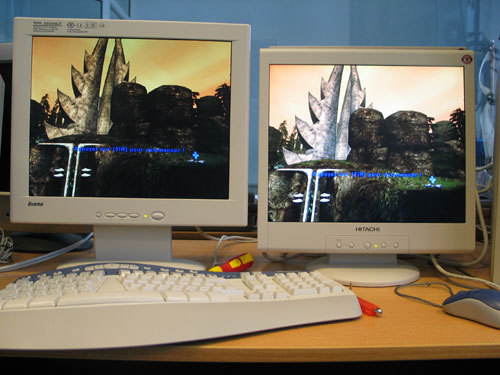An LCD Screen to Start the Year: Hitachi CML174SXW
Games
The screen is excellent. But a judgement of this kind is not really very productive. We have thus become much more critical than we are generally. Our remarks might sound too abrasive sometimes, but they only have one purpose, namely, to bring out certain points that remain to be improved on LCDs. Whatever the situation, there are very few CRTs that match up to this monitor.
Just Right for Games!
The first time we powered it up, the screen surprised us with its exceptional brightness. It is comparable to a Solarism LM1711. Yet the brightness claimed for the LM1711 is twice that of the CML174SXW (600 cd/sq. m., as opposed to 260 cd/sq. m.).
With classic impatience, we immediately launched the test that, as far as we are concerned, is the most revelatory of LCD quality - Unreal Tournament 2003. The colors are, quite simply, incredible. They are even brighter than those of the Solarism screen. Next to this, the colors on the Iiyama AS4314UTG look washed out. The image seems darkened, as if covered by an opaque veil. Yet recent owners of the AS4314UTG can take heart. Their monitor, announced as having a speed of 20 ms, benefits from a much better realtime response than that of the Hitachi screen. There is zero trailing on the AS4314UTG, and it is quite faint on the CML174SXW, but in the opinion of gamers using LCD and CRT screens (our own test panel remaining rather unrepresentative, consisting only of lab folks), the rendering is even good enough for a hardcore gamer. The trail is so faint that you forget it's there after 30 seconds.
On the left, the Iiyama AS4314UTG; on the right, the Hitachi CML174SXW. As in the following photos, the photo taken greatly exaggerates that actual rendering. However, it translates our claim quite clearly. The Hitachi screen produces an image that is much better contrasted but which looses a lot of shading in the paler shades of the image, as well as in the sky.
Iiyama also has the advantage when the image is viewed close-up. A rare occurrence, the Hitachi grid is visible. The pixel matrix is visible. This is rather disconcerting at first, but like the wake, you forget about it pretty quickly.
As for color rendering in a game situation, Hitachi usually comes out tops, thanks to the brightness, but not always. The brightness has limitations in the extreme shades that are not clearly defined. And it's on this very point that the Iiyama screen excels. As a result, the darkest images as well as the palest ones are more detailed in the Iiyama. Typically in the Hitachi, the image can appear to be washed out in the areas of great brightness, and the details are lost in areas of deep shadow.
Get Tom's Hardware's best news and in-depth reviews, straight to your inbox.
On the left, the Solarism LM1711; on the right, Hitachi's CML174SXW. The edge of the screen in this part of the UT2003 is more legible and more detailed on the Solarism screen than on the Hitachi.
Finally, consistently with all the other features, Quake 3, Unreal Tournament 2003, Dungeon Siege and similar games are displayed magnificently. The additional brightness of the colors is a great asset for games. The rendering superb, the trailing is still very slight. It's a real pleasure to play using this screen. A hint for people whose graphics cards are beginning to date a little: the CML174SXW is also very good at a resolution of 1024 x 768. The interpolation is much better than that of its two competitors.

